2007 ISUZU KB P190 lock
[x] Cancel search: lockPage 1205 of 6020
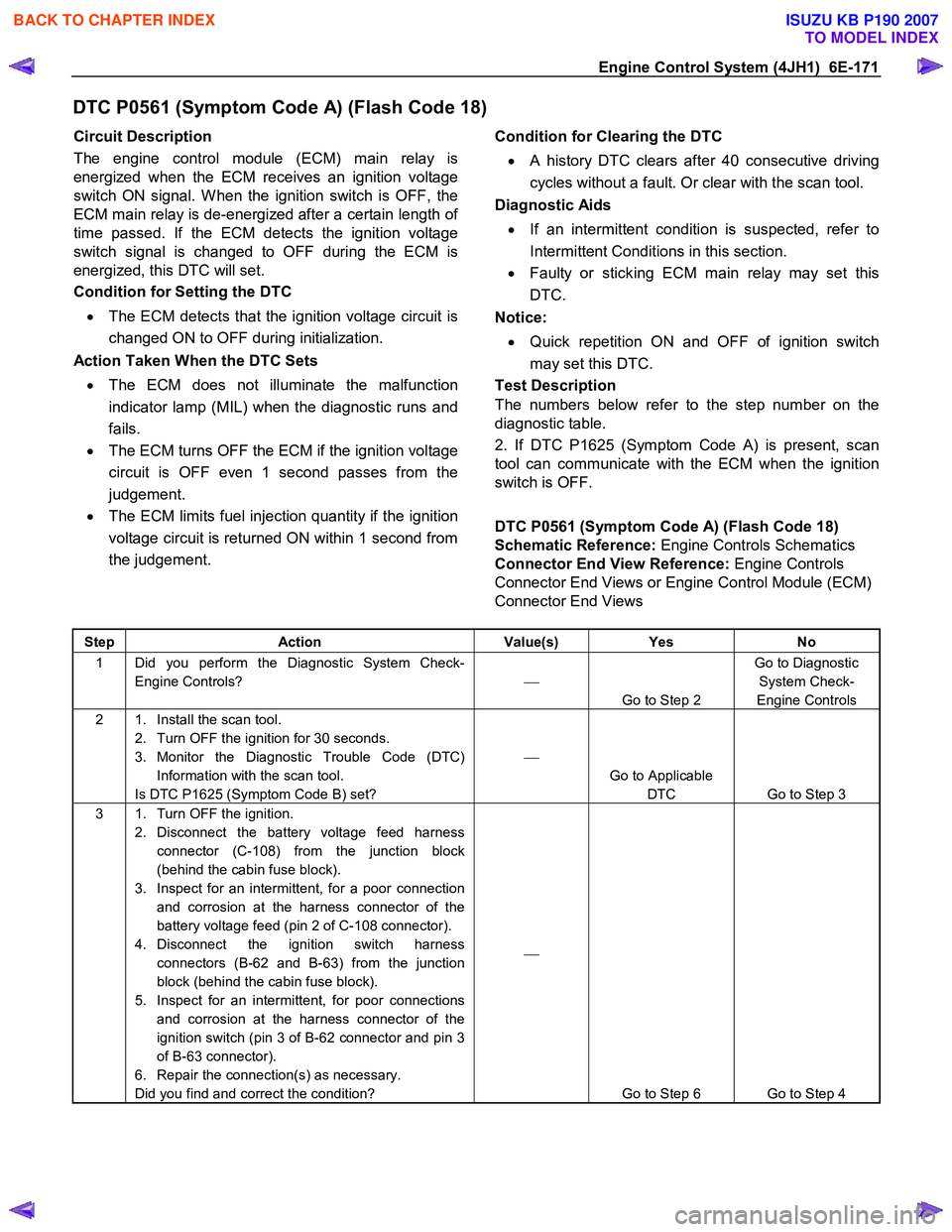
Engine Control System (4JH1) 6E-171
DTC P0561 (Symptom Code A) (Flash Code 18)
Circuit Description
The engine control module (ECM) main relay is
energized when the ECM receives an ignition voltage
switch ON signal. W hen the ignition switch is OFF, the
ECM main relay is de-energized after a certain length o
f
time passed. If the ECM detects the ignition voltage
switch signal is changed to OFF during the ECM is
energized, this DTC will set.
Condition for Setting the DTC
• The ECM detects that the ignition voltage circuit is
changed ON to OFF during initialization.
Action Taken When the DTC Sets
• The ECM does not illuminate the malfunction
indicator lamp (MIL) when the diagnostic runs and
fails.
• The ECM turns OFF the ECM if the ignition voltage
circuit is OFF even 1 second passes from the
judgement.
• The ECM limits fuel injection quantity if the ignition
voltage circuit is returned ON within 1 second from
the judgement.
Condition for Clearing the DTC
• A history DTC clears after 40 consecutive driving
cycles without a fault. Or clear with the scan tool.
Diagnostic Aids
• If an intermittent condition is suspected, refer to
Intermittent Conditions in this section.
• Faulty or sticking ECM main relay may set this
DTC.
Notice:
• Quick repetition ON and OFF of ignition switch
may set this DTC.
Test Description
The numbers below refer to the step number on the
diagnostic table.
2. If DTC P1625 (Symptom Code A) is present, scan
tool can communicate with the ECM when the ignition
switch is OFF.
DTC P0561 (Symptom Code A) (Flash Code 18)
Schematic Reference: Engine Controls Schematics
Connector End View Reference: Engine Controls
Connector End Views or Engine Control Module (ECM)
Connector End Views
Step Action Value(s) Yes No
1 Did you perform the Diagnostic System Check-
Engine Controls?
Go to Step 2 Go to Diagnostic
System Check-
Engine Controls
2 1. Install the scan tool. 2. Turn OFF the ignition for 30 seconds.
3. Monitor the Diagnostic Trouble Code (DTC) Information with the scan tool.
Is DTC P1625 (Symptom Code B) set?
Go to Applicable DTC Go to Step 3
3 1. Turn OFF the ignition. 2. Disconnect the battery voltage feed harness connector (C-108) from the junction block
(behind the cabin fuse block).
3. Inspect for an intermittent, for a poor connection and corrosion at the harness connector of the
battery voltage feed (pin 2 of C-108 connector).
4. Disconnect the ignition switch harness connectors (B-62 and B-63) from the junction
block (behind the cabin fuse block).
5. Inspect for an intermittent, for poor connections and corrosion at the harness connector of the
ignition switch (pin 3 of B-62 connector and pin 3
of B-63 connector).
6. Repair the connection(s) as necessary.
Did you find and correct the condition?
Go to Step 6 Go to Step 4
BACK TO CHAPTER INDEX
TO MODEL INDEX
ISUZU KB P190 2007
Page 1206 of 6020
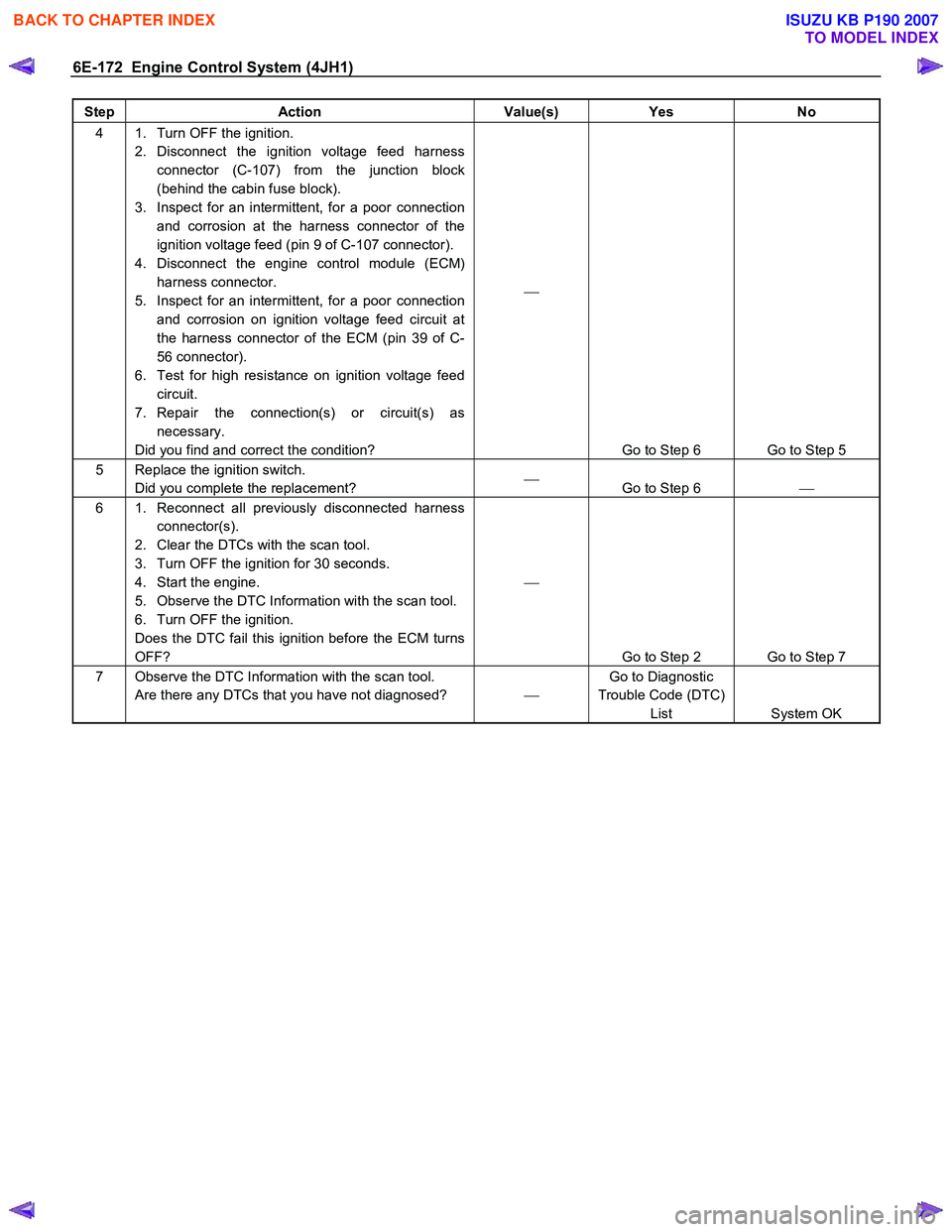
6E-172 Engine Control System (4JH1)
Step Action Value(s) Yes No
4 1. Turn OFF the ignition.
2. Disconnect the ignition voltage feed harness connector (C-107) from the junction block
(behind the cabin fuse block).
3. Inspect for an intermittent, for a poor connection and corrosion at the harness connector of the
ignition voltage feed (pin 9 of C-107 connector).
4. Disconnect the engine control module (ECM) harness connector.
5. Inspect for an intermittent, for a poor connection and corrosion on ignition voltage feed circuit at
the harness connector of the ECM (pin 39 of C-
56 connector).
6. Test for high resistance on ignition voltage feed circuit.
7. Repair the connection(s) or circuit(s) as necessary.
Did you find and correct the condition?
Go to Step 6 Go to Step 5
5 Replace the ignition switch. Did you complete the replacement?
Go to Step 6
6 1. Reconnect all previously disconnected harness
connector(s).
2. Clear the DTCs with the scan tool.
3. Turn OFF the ignition for 30 seconds.
4. Start the engine.
5. Observe the DTC Information with the scan tool.
6. Turn OFF the ignition.
Does the DTC fail this ignition before the ECM turns
OFF?
Go to Step 2 Go to Step 7
7 Observe the DTC Information with the scan tool. Are there any DTCs that you have not diagnosed? Go to Diagnostic
Trouble Code (DTC) List System OK
BACK TO CHAPTER INDEX
TO MODEL INDEX
ISUZU KB P190 2007
Page 1210 of 6020
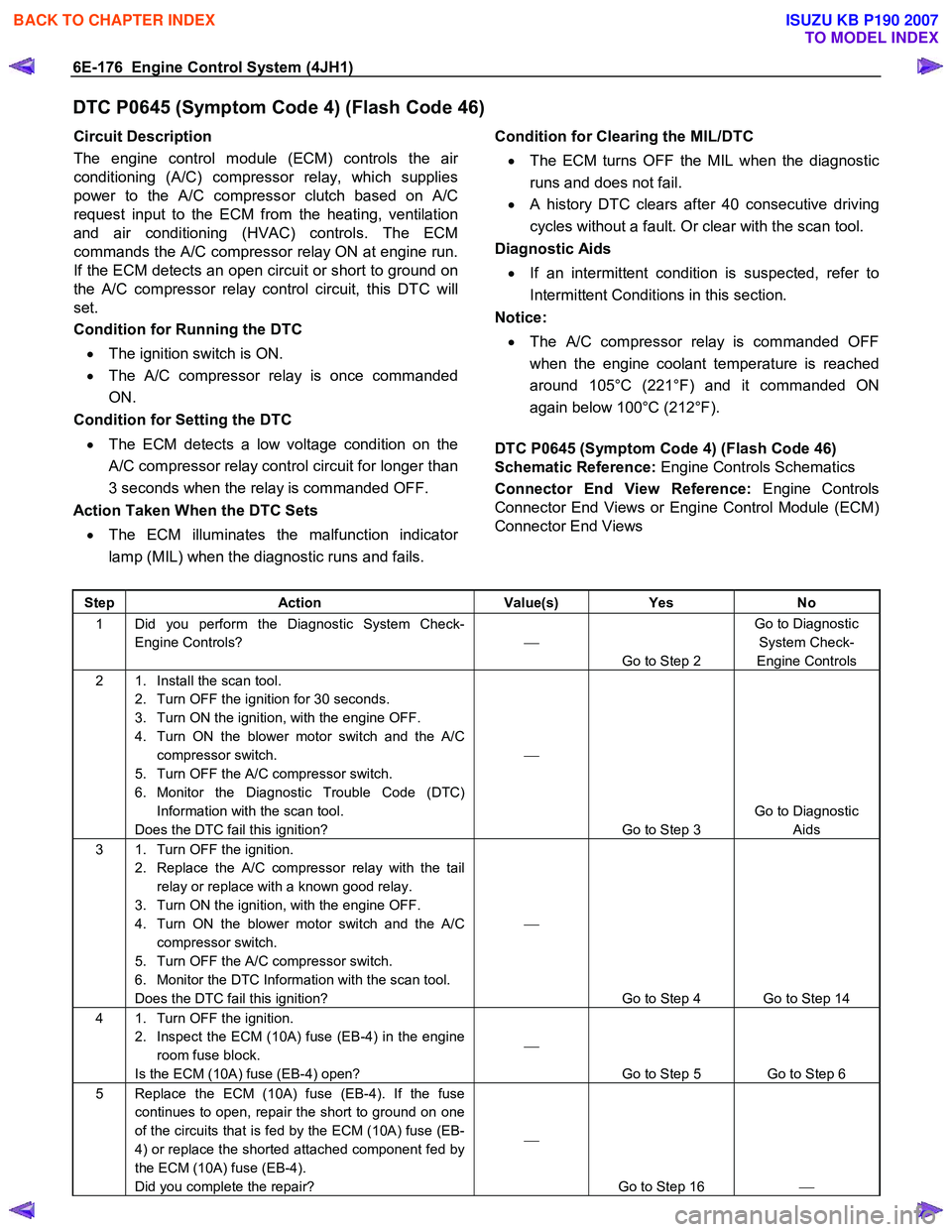
6E-176 Engine Control System (4JH1)
DTC P0645 (Symptom Code 4) (Flash Code 46)
Circuit Description
The engine control module (ECM) controls the ai
r
conditioning (A/C) compressor relay, which supplies
power to the A/C compressor clutch based on A/C
request input to the ECM from the heating, ventilation
and air conditioning (HVAC) controls. The ECM
commands the A/C compressor relay ON at engine run.
If the ECM detects an open circuit or short to ground on
the A/C compressor relay control circuit, this DTC will
set.
Condition for Running the DTC
• The ignition switch is ON.
• The A/C compressor relay is once commanded
ON.
Condition for Setting the DTC
• The ECM detects a low voltage condition on the
A/C compressor relay control circuit for longer than
3 seconds when the relay is commanded OFF.
Action Taken When the DTC Sets
• The ECM illuminates the malfunction indicato
r
lamp (MIL) when the diagnostic runs and fails.
Condition for Clearing the MIL/DTC
• The ECM turns OFF the MIL when the diagnostic
runs and does not fail.
• A history DTC clears after 40 consecutive driving
cycles without a fault. Or clear with the scan tool.
Diagnostic Aids
• If an intermittent condition is suspected, refer to
Intermittent Conditions in this section.
Notice:
• The A/C compressor relay is commanded OFF
when the engine coolant temperature is reached
around 105°C (221°F) and it commanded ON
again below 100°C (212°F).
DTC P0645 (Symptom Code 4) (Flash Code 46)
Schematic Reference: Engine Controls Schematics
Connector End View Reference: Engine Controls
Connector End Views or Engine Control Module (ECM)
Connector End Views
Step Action Value(s) Yes No
1 Did you perform the Diagnostic System Check-
Engine Controls?
Go to Step 2 Go to Diagnostic
System Check-
Engine Controls
2 1. Install the scan tool. 2. Turn OFF the ignition for 30 seconds.
3. Turn ON the ignition, with the engine OFF.
4. Turn ON the blower motor switch and the A/C compressor switch.
5. Turn OFF the A/C compressor switch.
6. Monitor the Diagnostic Trouble Code (DTC) Information with the scan tool.
Does the DTC fail this ignition?
Go to Step 3 Go to Diagnostic
Aids
3 1. Turn OFF the ignition. 2. Replace the A/C compressor relay with the tail relay or replace with a known good relay.
3. Turn ON the ignition, with the engine OFF.
4. Turn ON the blower motor switch and the A/C compressor switch.
5. Turn OFF the A/C compressor switch.
6. Monitor the DTC Information with the scan tool.
Does the DTC fail this ignition?
Go to Step 4 Go to Step 14
4 1. Turn OFF the ignition. 2. Inspect the ECM (10A) fuse (EB-4) in the engine room fuse block.
Is the ECM (10A) fuse (EB-4) open?
Go to Step 5 Go to Step 6
5 Replace the ECM (10A) fuse (EB-4). If the fuse continues to open, repair the short to ground on one
of the circuits that is fed by the ECM (10A) fuse (EB-
4) or replace the shorted attached component fed by
the ECM (10A) fuse (EB-4).
Did you complete the repair?
Go to Step 16
BACK TO CHAPTER INDEX
TO MODEL INDEX
ISUZU KB P190 2007
Page 1215 of 6020
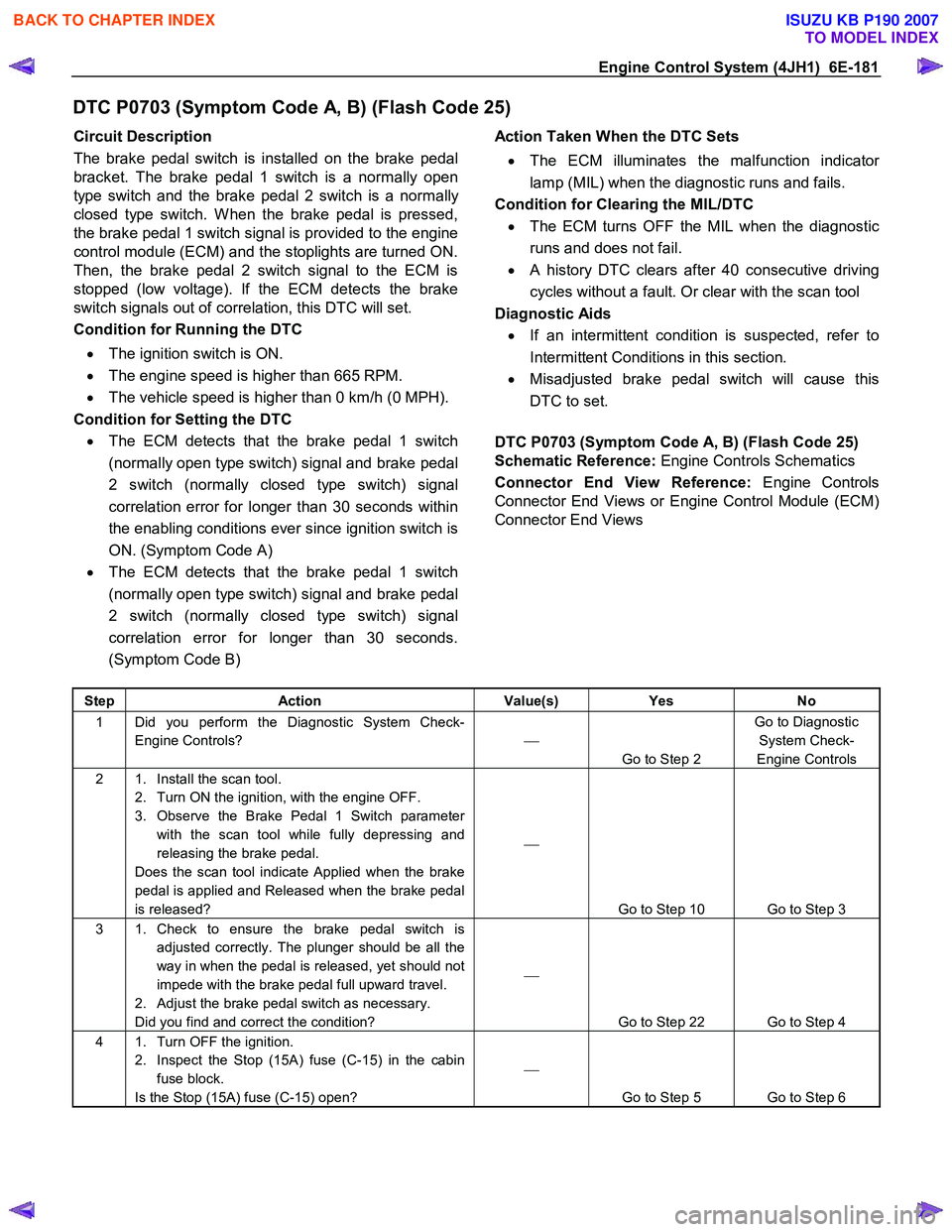
Engine Control System (4JH1) 6E-181
DTC P0703 (Symptom Code A, B) (Flash Code 25)
Circuit Description
The brake pedal switch is installed on the brake pedal
bracket. The brake pedal 1 switch is a normally open
type switch and the brake pedal 2 switch is a normally
closed type switch. W hen the brake pedal is pressed,
the brake pedal 1 switch signal is provided to the engine
control module (ECM) and the stoplights are turned ON.
Then, the brake pedal 2 switch signal to the ECM is
stopped (low voltage). If the ECM detects the brake
switch signals out of correlation, this DTC will set.
Condition for Running the DTC
• The ignition switch is ON.
• The engine speed is higher than 665 RPM.
• The vehicle speed is higher than 0 km/h (0 MPH).
Condition for Setting the DTC • The ECM detects that the brake pedal 1 switch
(normally open type switch) signal and brake pedal
2 switch (normally closed type switch) signal
correlation error for longer than 30 seconds within
the enabling conditions ever since ignition switch is
ON. (Symptom Code A)
• The ECM detects that the brake pedal 1 switch
(normally open type switch) signal and brake pedal
2 switch (normally closed type switch) signal
correlation error for longer than 30 seconds.
(Symptom Code B)
Action Taken When the DTC Sets
• The ECM illuminates the malfunction indicato
r
lamp (MIL) when the diagnostic runs and fails.
Condition for Clearing the MIL/DTC • The ECM turns OFF the MIL when the diagnostic
runs and does not fail.
• A history DTC clears after 40 consecutive driving
cycles without a fault. Or clear with the scan tool
Diagnostic Aids • If an intermittent condition is suspected, refer to
Intermittent Conditions in this section.
• Misadjusted brake pedal switch will cause this
DTC to set.
DTC P0703 (Symptom Code A, B) (Flash Code 25)
Schematic Reference: Engine Controls Schematics
Connector End View Reference: Engine Controls
Connector End Views or Engine Control Module (ECM)
Connector End Views
Step Action Value(s) Yes No
1 Did you perform the Diagnostic System Check-
Engine Controls?
Go to Step 2 Go to Diagnostic
System Check-
Engine Controls
2 1. Install the scan tool. 2. Turn ON the ignition, with the engine OFF.
3. Observe the Brake Pedal 1 Switch parameter with the scan tool while fully depressing and
releasing the brake pedal.
Does the scan tool indicate Applied when the brake
pedal is applied and Released when the brake pedal
is released?
Go to Step 10 Go to Step 3
3 1. Check to ensure the brake pedal switch is adjusted correctly. The plunger should be all the
way in when the pedal is released, yet should not
impede with the brake pedal full upward travel.
2. Adjust the brake pedal switch as necessary.
Did you find and correct the condition?
Go to Step 22 Go to Step 4
4 1. Turn OFF the ignition. 2. Inspect the Stop (15A) fuse (C-15) in the cabin fuse block.
Is the Stop (15A) fuse (C-15) open?
Go to Step 5 Go to Step 6
BACK TO CHAPTER INDEX
TO MODEL INDEX
ISUZU KB P190 2007
Page 1216 of 6020
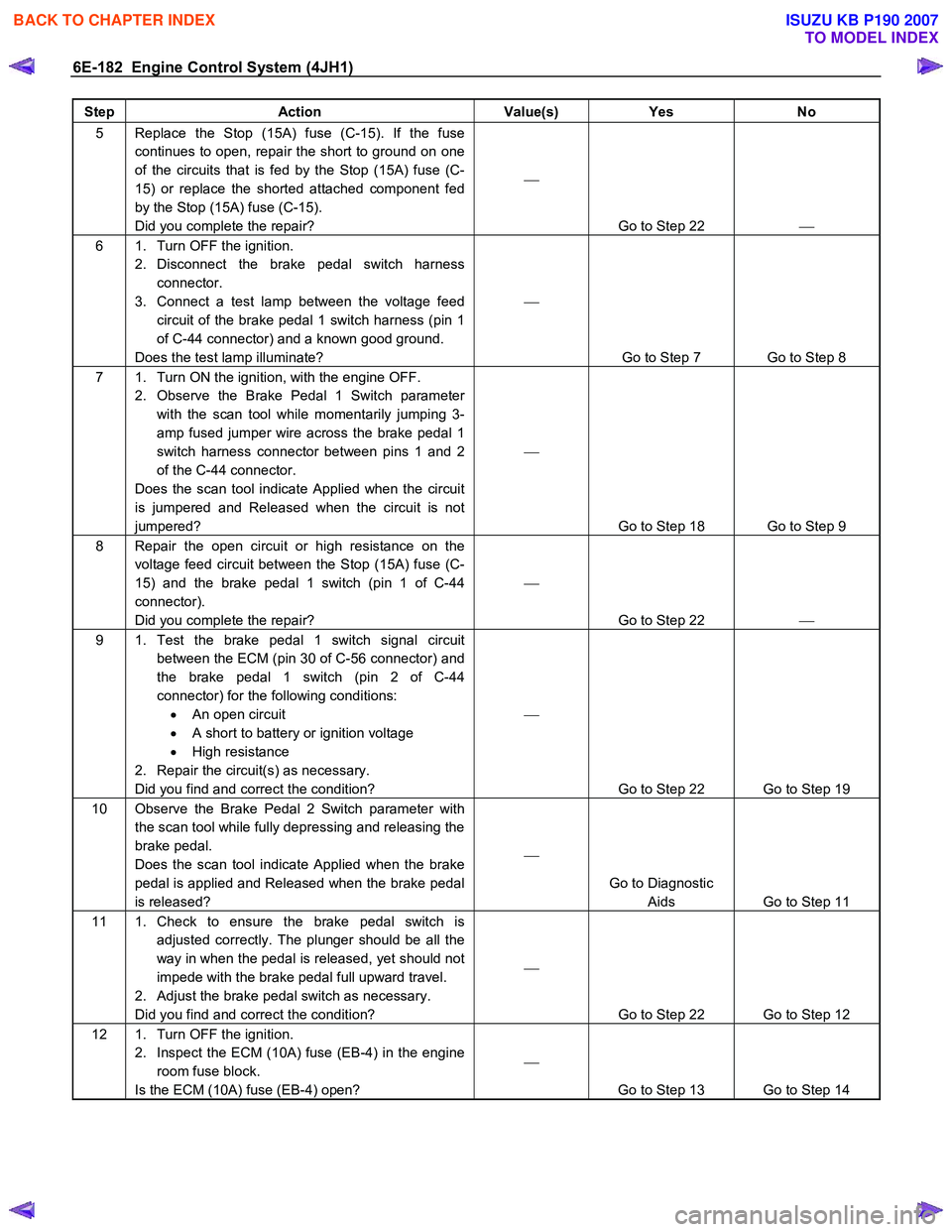
6E-182 Engine Control System (4JH1)
Step Action Value(s) Yes No
5 Replace the Stop (15A) fuse (C-15). If the fuse
continues to open, repair the short to ground on one
of the circuits that is fed by the Stop (15A) fuse (C-
15) or replace the shorted attached component fed
by the Stop (15A) fuse (C-15).
Did you complete the repair?
Go to Step 22
6 1. Turn OFF the ignition.
2. Disconnect the brake pedal switch harness connector.
3. Connect a test lamp between the voltage feed circuit of the brake pedal 1 switch harness (pin 1
of C-44 connector) and a known good ground.
Does the test lamp illuminate?
Go to Step 7 Go to Step 8
7 1. Turn ON the ignition, with the engine OFF. 2. Observe the Brake Pedal 1 Switch parameter with the scan tool while momentarily jumping 3-
amp fused jumper wire across the brake pedal 1
switch harness connector between pins 1 and 2
of the C-44 connector.
Does the scan tool indicate Applied when the circuit
is jumpered and Released when the circuit is not
jumpered?
Go to Step 18 Go to Step 9
8 Repair the open circuit or high resistance on the voltage feed circuit between the Stop (15A) fuse (C-
15) and the brake pedal 1 switch (pin 1 of C-44
connector).
Did you complete the repair?
Go to Step 22
9 1. Test the brake pedal 1 switch signal circuit
between the ECM (pin 30 of C-56 connector) and
the brake pedal 1 switch (pin 2 of C-44
connector) for the following conditions: • An open circuit
• A short to battery or ignition voltage
• High resistance
2. Repair the circuit(s) as necessary.
Did you find and correct the condition?
Go to Step 22 Go to Step 19
10 Observe the Brake Pedal 2 Switch parameter with the scan tool while fully depressing and releasing the
brake pedal.
Does the scan tool indicate Applied when the brake
pedal is applied and Released when the brake pedal
is released?
Go to Diagnostic Aids Go to Step 11
11 1. Check to ensure the brake pedal switch is
adjusted correctly. The plunger should be all the
way in when the pedal is released, yet should not
impede with the brake pedal full upward travel.
2. Adjust the brake pedal switch as necessary.
Did you find and correct the condition?
Go to Step 22 Go to Step 12
12 1. Turn OFF the ignition. 2. Inspect the ECM (10A) fuse (EB-4) in the engine room fuse block.
Is the ECM (10A) fuse (EB-4) open?
Go to Step 13 Go to Step 14
BACK TO CHAPTER INDEX
TO MODEL INDEX
ISUZU KB P190 2007
Page 1219 of 6020
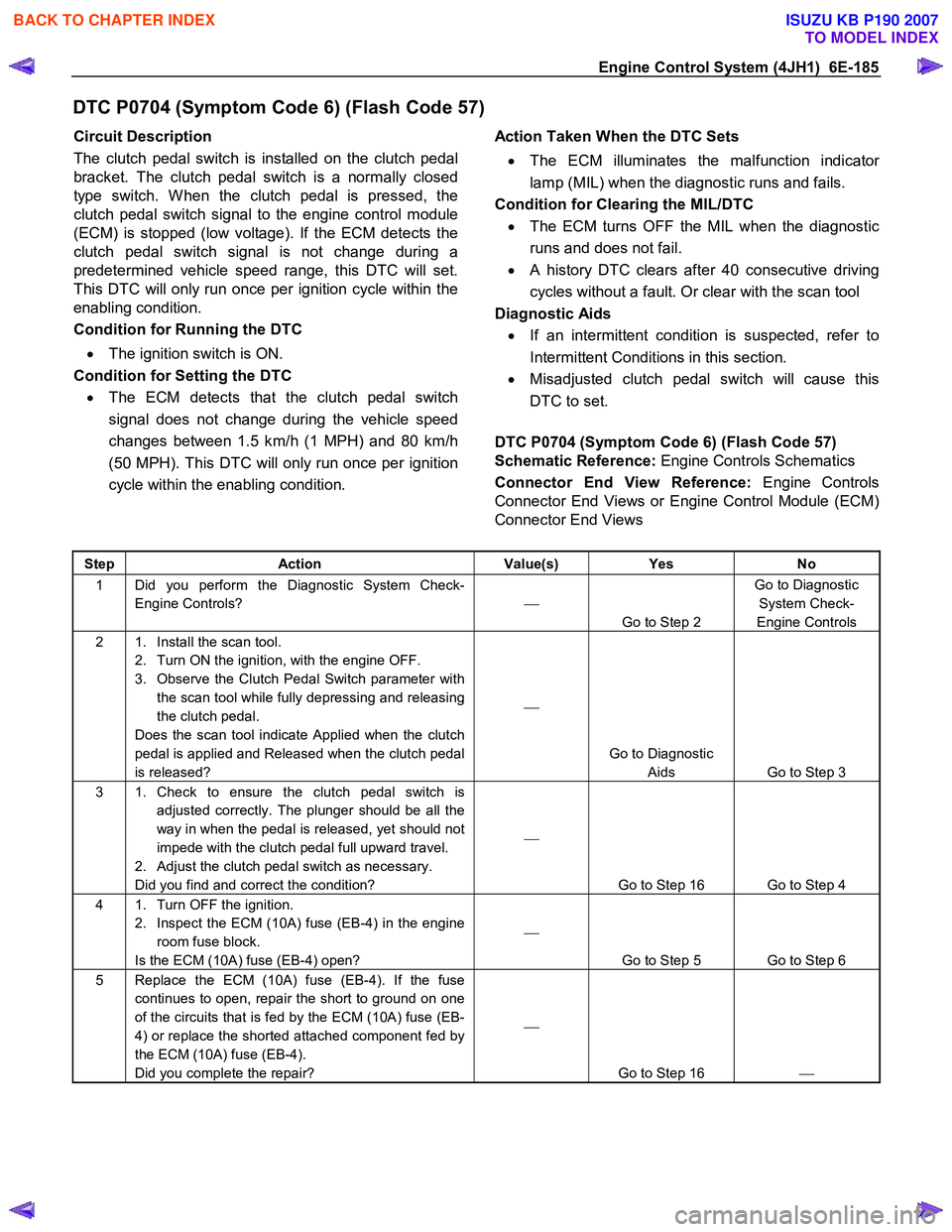
Engine Control System (4JH1) 6E-185
DTC P0704 (Symptom Code 6) (Flash Code 57)
Circuit Description
The clutch pedal switch is installed on the clutch pedal
bracket. The clutch pedal switch is a normally closed
type switch. W hen the clutch pedal is pressed, the
clutch pedal switch signal to the engine control module
(ECM) is stopped (low voltage). If the ECM detects the
clutch pedal switch signal is not change during a
predetermined vehicle speed range, this DTC will set.
This DTC will only run once per ignition cycle within the
enabling condition.
Condition for Running the DTC
• The ignition switch is ON.
Condition for Setting the DTC • The ECM detects that the clutch pedal switch
signal does not change during the vehicle speed
changes between 1.5 km/h (1 MPH) and 80 km/h
(50 MPH). This DTC will only run once per ignition
cycle within the enabling condition.
Action Taken When the DTC Sets
• The ECM illuminates the malfunction indicato
r
lamp (MIL) when the diagnostic runs and fails.
Condition for Clearing the MIL/DTC • The ECM turns OFF the MIL when the diagnostic
runs and does not fail.
• A history DTC clears after 40 consecutive driving
cycles without a fault. Or clear with the scan tool
Diagnostic Aids • If an intermittent condition is suspected, refer to
Intermittent Conditions in this section.
• Misadjusted clutch pedal switch will cause this
DTC to set.
DTC P0704 (Symptom Code 6) (Flash Code 57)
Schematic Reference: Engine Controls Schematics
Connector End View Reference: Engine Controls
Connector End Views or Engine Control Module (ECM)
Connector End Views
Step Action Value(s) Yes No
1 Did you perform the Diagnostic System Check-
Engine Controls?
Go to Step 2 Go to Diagnostic
System Check-
Engine Controls
2 1. Install the scan tool. 2. Turn ON the ignition, with the engine OFF.
3. Observe the Clutch Pedal Switch parameter with the scan tool while fully depressing and releasing
the clutch pedal.
Does the scan tool indicate Applied when the clutch
pedal is applied and Released when the clutch pedal
is released?
Go to Diagnostic Aids Go to Step 3
3 1. Check to ensure the clutch pedal switch is adjusted correctly. The plunger should be all the
way in when the pedal is released, yet should not
impede with the clutch pedal full upward travel.
2. Adjust the clutch pedal switch as necessary.
Did you find and correct the condition?
Go to Step 16 Go to Step 4
4 1. Turn OFF the ignition. 2. Inspect the ECM (10A) fuse (EB-4) in the engine room fuse block.
Is the ECM (10A) fuse (EB-4) open?
Go to Step 5 Go to Step 6
5 Replace the ECM (10A) fuse (EB-4). If the fuse continues to open, repair the short to ground on one
of the circuits that is fed by the ECM (10A) fuse (EB-
4) or replace the shorted attached component fed by
the ECM (10A) fuse (EB-4).
Did you complete the repair?
Go to Step 16
BACK TO CHAPTER INDEX
TO MODEL INDEX
ISUZU KB P190 2007
Page 1247 of 6020
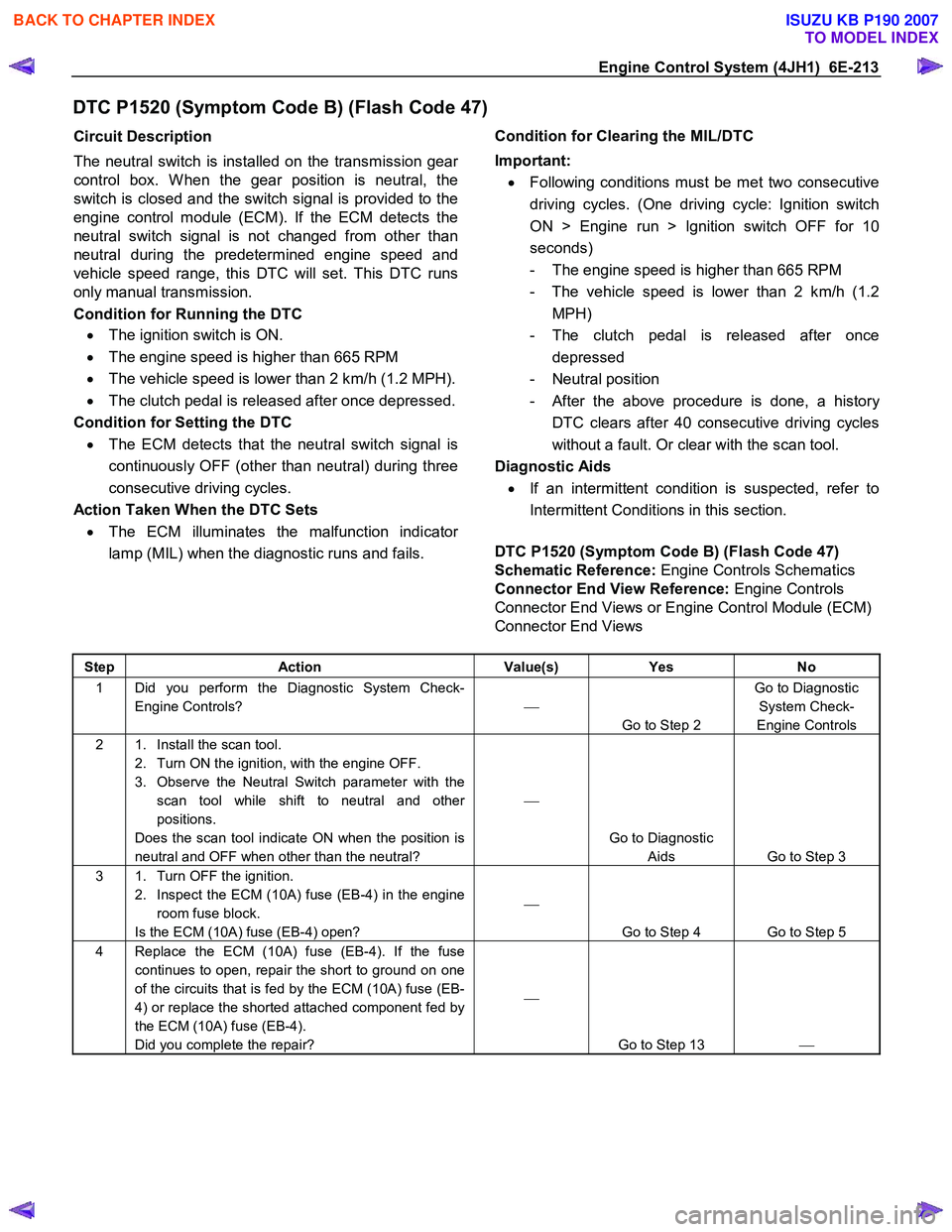
Engine Control System (4JH1) 6E-213
DTC P1520 (Symptom Code B) (Flash Code 47)
Circuit Description
The neutral switch is installed on the transmission gea
r
control box. W hen the gear position is neutral, the
switch is closed and the switch signal is provided to the
engine control module (ECM). If the ECM detects the
neutral switch signal is not changed from other than
neutral during the predetermined engine speed and
vehicle speed range, this DTC will set. This DTC runs
only manual transmission.
Condition for Running the DTC
• The ignition switch is ON.
• The engine speed is higher than 665 RPM
• The vehicle speed is lower than 2 km/h (1.2 MPH).
• The clutch pedal is released after once depressed.
Condition for Setting the DTC • The ECM detects that the neutral switch signal is
continuously OFF (other than neutral) during three
consecutive driving cycles.
Action Taken When the DTC Sets • The ECM illuminates the malfunction indicato
r
lamp (MIL) when the diagnostic runs and fails.
Condition for Clearing the MIL/DTC
Important: • Following conditions must be met two consecutive
driving cycles. (One driving cycle: Ignition switch
ON > Engine run > Ignition switch OFF for 10
seconds)
- The engine speed is higher than 665 RPM
- The vehicle speed is lower than 2 km/h (1.2 MPH)
- The clutch pedal is released after once depressed
- Neutral position
- After the above procedure is done, a history
DTC clears after 40 consecutive driving cycles
without a fault. Or clear with the scan tool.
Diagnostic Aids
• If an intermittent condition is suspected, refer to
Intermittent Conditions in this section.
DTC P1520 (Symptom Code B) (Flash Code 47)
Schematic Reference: Engine Controls Schematics
Connector End View Reference: Engine Controls
Connector End Views or Engine Control Module (ECM)
Connector End Views
Step Action Value(s) Yes No
1 Did you perform the Diagnostic System Check-
Engine Controls?
Go to Step 2 Go to Diagnostic
System Check-
Engine Controls
2 1. Install the scan tool. 2. Turn ON the ignition, with the engine OFF.
3. Observe the Neutral Switch parameter with the scan tool while shift to neutral and other
positions.
Does the scan tool indicate ON when the position is
neutral and OFF when other than the neutral?
Go to Diagnostic Aids Go to Step 3
3 1. Turn OFF the ignition. 2. Inspect the ECM (10A) fuse (EB-4) in the engine room fuse block.
Is the ECM (10A) fuse (EB-4) open?
Go to Step 4 Go to Step 5
4 Replace the ECM (10A) fuse (EB-4). If the fuse continues to open, repair the short to ground on one
of the circuits that is fed by the ECM (10A) fuse (EB-
4) or replace the shorted attached component fed by
the ECM (10A) fuse (EB-4).
Did you complete the repair?
Go to Step 13
BACK TO CHAPTER INDEX
TO MODEL INDEX
ISUZU KB P190 2007
Page 1268 of 6020

6E-234 Engine Control System (4JH1)
DTC P1690 (Symptom Code 4) (Flash Code 77)
Circuit Description
The malfunction indicator lamp (MIL) is located on the
instrument panel cluster (IPC). The battery voltage is
supplied to the MIL. The engine control module (ECM)
turns the MIL ON by grounding the MIL control circuit.
After a fixed time passes, the ECM turns OFF the MIL
with the ignition ON and the engine OFF. The MIL has
the following functions:
• The MIL informs the driver that a malfunction has
occurred and the vehicle should be taken in fo
r
service as soon as possible.
• The MIL illuminates during a bulb test and a
system test.
•
A DTC will be stored if a MIL is requested by the
ECM.
If the ECM detects an open circuit or short circuit on the
MIL control circuit, this DTC will set.
Condition for Running the DTC • The ignition switch is ON.
Condition for Setting the DTC
• The ECM detects a low voltage condition on the
MIL control circuit for longer than 3 seconds when
the MIL is commanded OFF.
Action Taken When the DTC Sets • The ECM does not illuminates the MIL when the
diagnostic runs and fails.
Condition for Clearing the DTC • A history DTC clears after 40 consecutive driving
cycles without a fault. Or clear with the scan tool.
Diagnostic Aids
• If an intermittent condition is suspected, refer to
Intermittent Conditions in this section.
DTC P1690 (Symptom Code 4) (Flash Code 77)
Schematic Reference: Engine Controls Schematics
Connector End View Reference: Engine Controls
Connector End Views or Engine Control Module (ECM)
Connector End Views
Step Action Value(s) Yes No
1 Did you perform the Diagnostic System Check-
Engine Controls?
Go to Step 2 Go to Diagnostic
System Check-
Engine Controls
2 1. Install the scan tool. 2. Turn ON the ignition, with the engine OFF.
3. Perform the Malfunction Indicator Lamp (MIL) test with the scan tool.
4. Command the MIL ON with the scan tool.
Does the MIL turn ON when commanded ON with
the scan tool?
Go to Step 3 Go to Step 4
3 Command the MIL OFF with the scan tool. Does the MIL OFF?
Go to Step 17 Go to Step 10
4 1. Turn OFF the ignition.
2. Inspect the Meter (15A) fuse (C-14) in the cabin fuse block.
Is the Meter (15A) fuse (C-14) open?
Go to Step 5 Go to Step 6
5 Replace the Meter (15A) fuse (C-14). If the fuse continues to open, repair the short to ground on one
of the circuits that fed by the Meter (15A) fuse (C-14)
or replace the shorted attached component fed by
the Meter (15A) fuse (C-14).
Did you complete the repair?
Go to Step 19
6 1. Turn OFF the ignition.
2. Disconnect the engine control module (ECM) harness connector.
3. Turn ON the ignition, with the engine OFF.
4. Connect a 3-amp fused jumper wire between the MIL control circuit of the ECM harness connector
(pin 42 of C-56 connector) and a known good
ground.
Does the MIL illuminate?
Go to Step 11 Go to Step 7
BACK TO CHAPTER INDEX
TO MODEL INDEX
ISUZU KB P190 2007